To Mock the Stupendous Mechanism: Designing The Motherbrain’s WSW Console
How producer and studio owner Brian Bender turned a time capsule into a modern-day tone machine. Click to read the first, second, third and fourth parts of the series.
PART 5: BUILDING IT
So now comes the coolest and the hardest part, build the fucking thing.
Building was something I grew up with. One grandfather was an architect, the other a farmer, butcher, tailor, Navy Sailor, and rootbeersman. My Dad and his two brothers owned a lumber company and my Dad could build just about anything, not the least of which included the house I grew up in. He had a full-on machine shop in the garage (land is cheap in Indiana). As a kid, I cut a chess set on a metal lathe, ripped frets off pawn shop basses to try to cop Jaco’s sound, and made countless messes besides under his watchful gaze.
Meanwhile, Mom co-owned a home furnishings store in a very hip little corner of our tiny downtown, curating a beautiful selection of finds, repurposed vintage items, and tasteful modern. In her spare time, she bought, restored, and resold houses. It was never about flipping, however, more an organic re-imagining of the canvas until she’d finished and felt it was time to move on. The last house she built was assembled from lumber salvaged out of two barns and was a crazy exposed-beam barn loft with 35-foot ceilings. It was the best kind of nuts.
This little heart-warming digression is strictly motivated by how important it is to understand how much of a badass Francois Chambard is at this point in the tale.
Even with all this history, I would have absolutely no concept of how to approach building something like this console. The scale, the weight, ergonomics, resonance. No way. Frankly, the only reason I can even comment on my own ignorance with any clarity is because Francois has already built it.
Francois is one of the warmest and most unassuming people I’ve ever had the pleasure of collaborating with. When we were introduced, he had already built UM Project, and had been working away for several years to build an impressive body of work. Francois is never one to brag so I just took it as the obvious truth that he had been educated in design, interned, workshopped, and just generally hustled his ass off in the interest of this enterprise for the entirety of his adult life.
During our meetings and friendly chats over coffee and tea the little details began to come out and, over the course of the months and years that followed, I started to get a picture of what an interesting and strange path had taken him to this point in his life.
Francois’ first project on a very large scale was Elias Arts’ beautiful THX-certified mixing room, complete with an insane wrap-around fiberglass desk with a small, wheeled, satellite portion that houses the display monitors such that the mixing engineer can ideally situate in the 5.1 sweet spot. As it turned out, Francois had actually been working for Elias as a branding and design consultant when they began the renovation, and told Scott Elias that he wanted to build the new studio. Naturally, he absolutely killed it and that cemented the possibility of a full-time transition to tangible making.
That’s only the tip of the iceberg of the strange and interesting things that he’s done, however. He jocularly alluded to a brief life as a NY bike messenger when he first moved to the city. Allen [Farmelo] and he gently circumlocuted his time as a French soldier, stationed in a ski patrol in the Alps. When I finally asked him point blank how he got his start as a builder, he proudly described his tenure with Hank Gilpin, one of America’s top furniture makers. From the stories, it sounded like Hank is equal parts Mr. Miyagi and Yoda. Francois described only using hand tools for the first year of his apprenticeship, patiently hand planning, sanding, and sawing, favoring accuracy and love for the materials over speed.
From the Elias project, he met Emily Lazar at The Lodge and built an incredible set of furniture for the reception area, including chairs that have iPod docks built right in so The Lodge clients could comfortably reference Masters in a comfortable and beautiful environment. They loved his work so much that they turned to him when they expanded their facilities to include the impressive audio post house, The Station. For this project, Francois designed, built, and installed the entire space, from soup to nuts.
Through his work at The Lodge Music & The Station, he met Andy Hong from Tape Op, which gave way to meeting Allen Farmelo and thus, giving rise to his first custom console amazingness. This path is the type of fascinating and natural succession that is the only way to get into this particular niche, I think.
Given that he already had so much experience with studio design and practical experience in building desks with Farmelo’s API being such a triumph, he hopped right in on my console, completely unperturbed.
DESIGN DECISIONS
In order to offer optimal rigidity and lower the weight, he opted to make the main frame out of a combination of heavy birch ply (several parts in custom width laminates up to 15 or more ply’s) and steel fins.
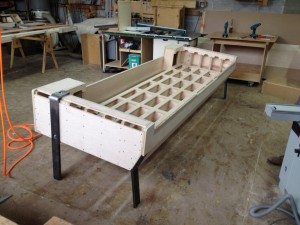
The torsion box connected to the block ends, up on legs. Notice the raw steel, this is a rough-in, pre-enameling.
The main body of the frame is a torsion box with several hand-routed holes in order to lower the weight significantly. This box bolts to a pair of heavy duty ends, which then serve to offer connection points for both the Ash finish panels as well as the series of highly customized blocks that bolt in between the steel fins, running front to back. These steel pieces offer connections for the WSW frames as well as the rack rails on the other side of the console.
The entire console kind of bolts together in two large pieces, built from several constituent parts: The torsion box, legs and block ends comprise the base, the blocks for the armrest and meter bridge and all the fins make up the top. We assembled the two halves separately, set the box on the legs on the ground and then CAREFULLY hossed the extremely heavy top into place.
After these two pieces were mated, the finish parts, the ceramic steel rest and bridge, Ash panels, and brass appointments were carefully attached and we had the frame!
Over the course of a very long day in Francois’ beautiful Greenpoint shop, we got to take part in the physical realization of this dream. I really can’t begin to describe the emotional response that Francois, Jon, Taft (our newest staff member!), and I had as the line drawing gave way to a tangible, tactile, piece of art that was now to become the center of my professional life.
NO GUTS NO GLORY
Meanwhile, back down at the studio in Sunset Park, Jon, Taft, and I had been seriously busting ass on a renovation of the control room in order to prep for the arrival of this beast.
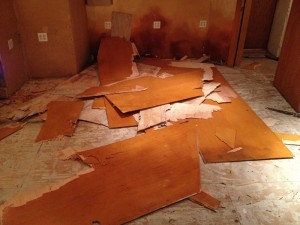
The beginning of the end. Our former floors were finished in 1/8th” veneer that yielded easily to a 36″ bar. The stuff below it? Not so much.
The floors here were utterly beat and needed replacement badly. The unfortunate truth is that they were also poorly designed and so our only real recourse was to start over from the slab. The original design didn’t include provisions for accessible cable troughs and so I had no choice in the upgrade process other than to leave the significant amount of extra wiring I had brought in tucked “neatly” behind racks on the floor. It looked like shit. Also, there had been some water damage, so a fair amount of the fabric on the ceiling and walls had been badly stained and would need replacement.
The entirety of the space in which I work was actually a handyman special, I think, and so had a series of aesthetic choices that were kind of quirky. (Read: also shitty.) Talmbout hand painted puff paint spheres looking into infinity through a dark wood on the acoustic panels in the control room. The walls and ceiling were upholstered in literally the ugliest blue color that Guilford offers. Ha.
There was no way we were going to suffer that environment for this freaking sculpture that MOMA would love to have on display.
So, we gutted it.
I took two pry bars and ripped the floors down all the way to slab. The sandwich was veneer, ½” ply, ½’ sheetrock and ¾” ply, and then that all rested on rubber pucks which was all affixed to the slab via powder actuated fasteners. Over the course of a very demanding and very stress relieving week, all that stuff came up and we started over from zero.
One unfortunate flaw we found at that point was that the original builder hadn’t put down any sort of vapor barrier between the concrete and the flooring and so mold had begun to creep up through all the layers of the floor. It was deeply gross and also pretty scary, considering the amount of time we all put down in that room in any given day.
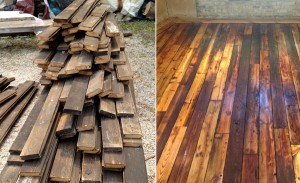
On the left, the rather poor state in which we received the pine. On the right, as seen after caring for every surface of each board to get the puzzle to fit, drum sanding, and 9 layers of tung oil.
A friend back in my hometown of Bloomington, Indiana owns a really rad architectural salvage company and happened to have some incredible reclaimed heart pine for sale. This lumber was absolutely gorgeous and cheaper than the cheap, off-the-shelf stuff I had been looking at locally. It just so happened that I was in Bloomington to see the family and move some long left behind heirlooms and so my better half and I already had plans on driving back out in a van.
We loaded up the flooring on a sweaty, horrible Indiana summer day and bounced our way across the country in a U-Haul.
I’ll spare you’re the gory details, but suffice it to say; getting that floor to fit was a serious endeavor. We had to plane both faces, sand tongues, and take a router to the grooves. LOTS of work. The end result, however, is well worth all the effort.
Looking back through all the texts that Francois and I were shooting back and forth during this time period is seriously awesome. So many pictures of us racing each other to finish in the window we’d set out. I was literally booking moving vans to get the parts down to the studio in between applying the final coats of Tung oil to the floor. Exciting, exhausting, and inspiring.
All the images from this particular entry are compiled exclusively from the texts we were sending back and forth during this period.
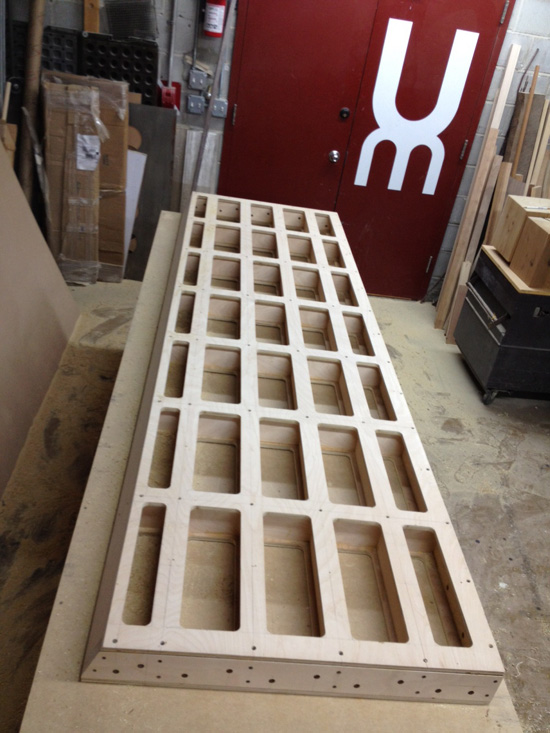
Detail of the torsion box. Francois later decided that the plywood was too unattractive unclad (mind you, it’s invisible except if you crane your neck behind the display monitor), and so he added an additional finish layer. Just because. This entire box was done with a handheld router, no computer-aided or automated tools.
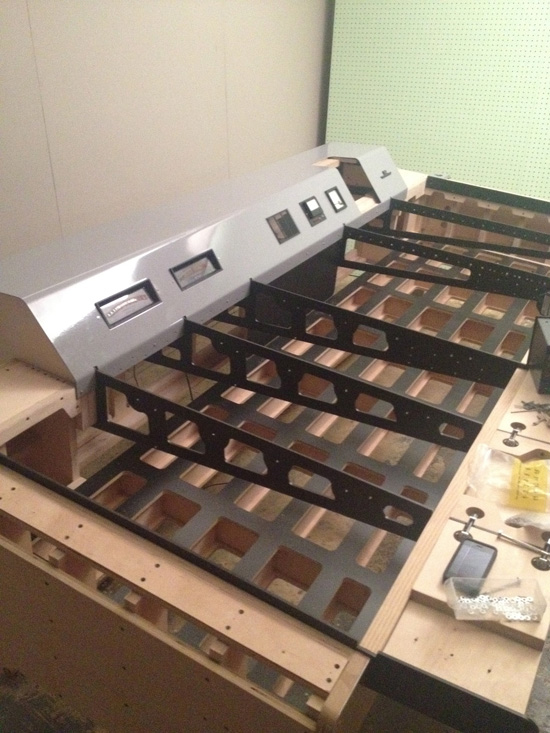
The top section with the metal fins, in place on the lower torsion box. Meterbridge roughed-in for effect. This is full assembly #1, at Francois’ studio, setting up for the glamour shots. Getting really close to dropping gear in…
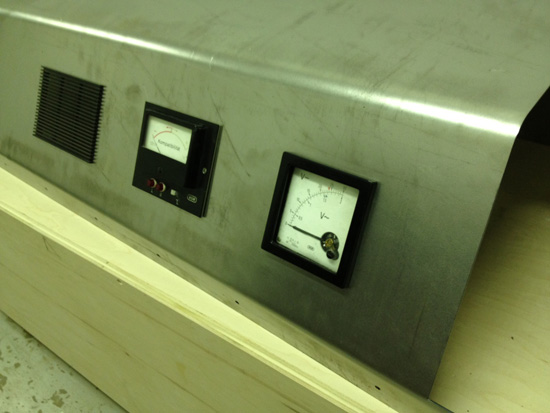
The original WSW voltage meter, phase meter, and speaker grille, reclaimed from the original meter bridge and roughed into the new.
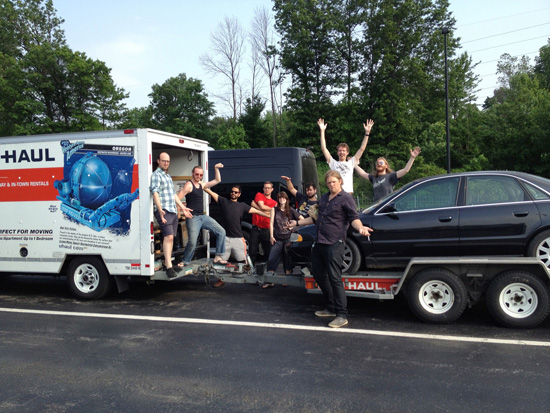
Thanks to Twitter and Google Maps, Julianna and I ran into Sister Sparrow and the Dirty Birds on I-80! They were out touring an album we had freshly minted together back at the Motherbrain!
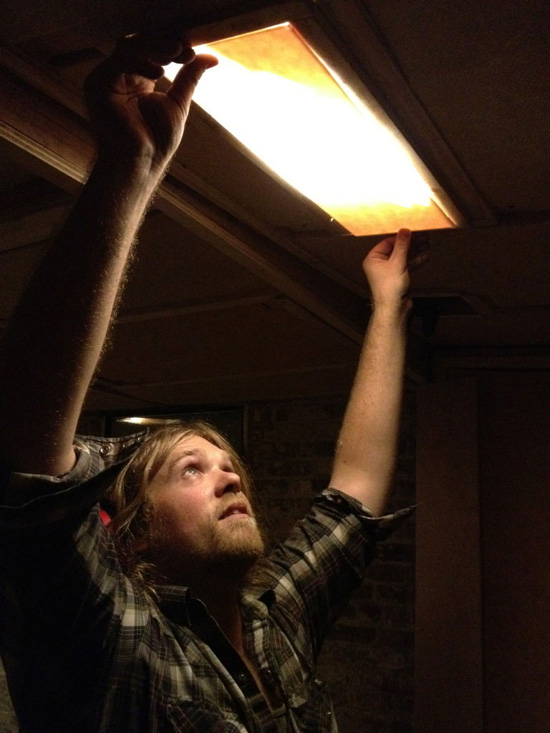
Studio Renovations: This is the first light I’ve ever made. Here, I’m roughing in the white plexi (the backing paper is still attached to keep the plexi nicey unscratched). I cut the frame out of the same stock as the floor and we used brass screws to continue the theme of materials.
Next up! Dr. Faust makes a deal with Rupert Neve…
Brian Bender has enjoyed the pleasure of running sessions at Looking Glass, The Hit Factory, Electric Lady and many more beautiful rooms in New York and beyond. His co-conspirators include names as diverse as Philip Glass, The Counting Crows, Al Green, Borusan Philarmonie and Craig Street. Recent clients include Krystle Warren and the Faculty, Sister Sparrow and the Dirty Birds, Jose James and Langhorne Slim.
Please note: When you buy products through links on this page, we may earn an affiliate commission.







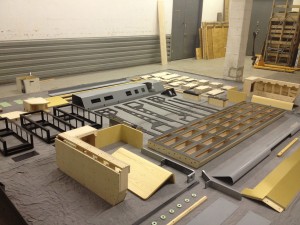
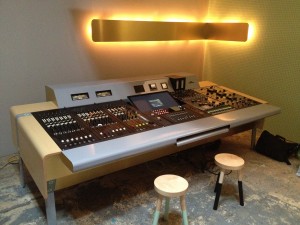
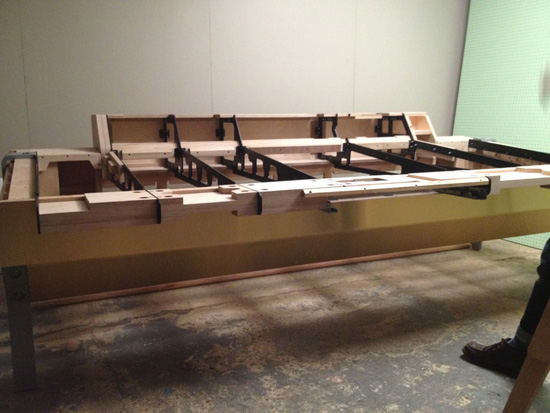
The War Rooms
April 22, 2013 at 3:09 pm (11 years ago)OMFrG, this is just amazing. I use a stereo 811510 strip every day and am yet to hear another pre that kills on absolutely everything like these do. It’s very tough to mix old and new successfully, but you have nailed it. Wonderful.